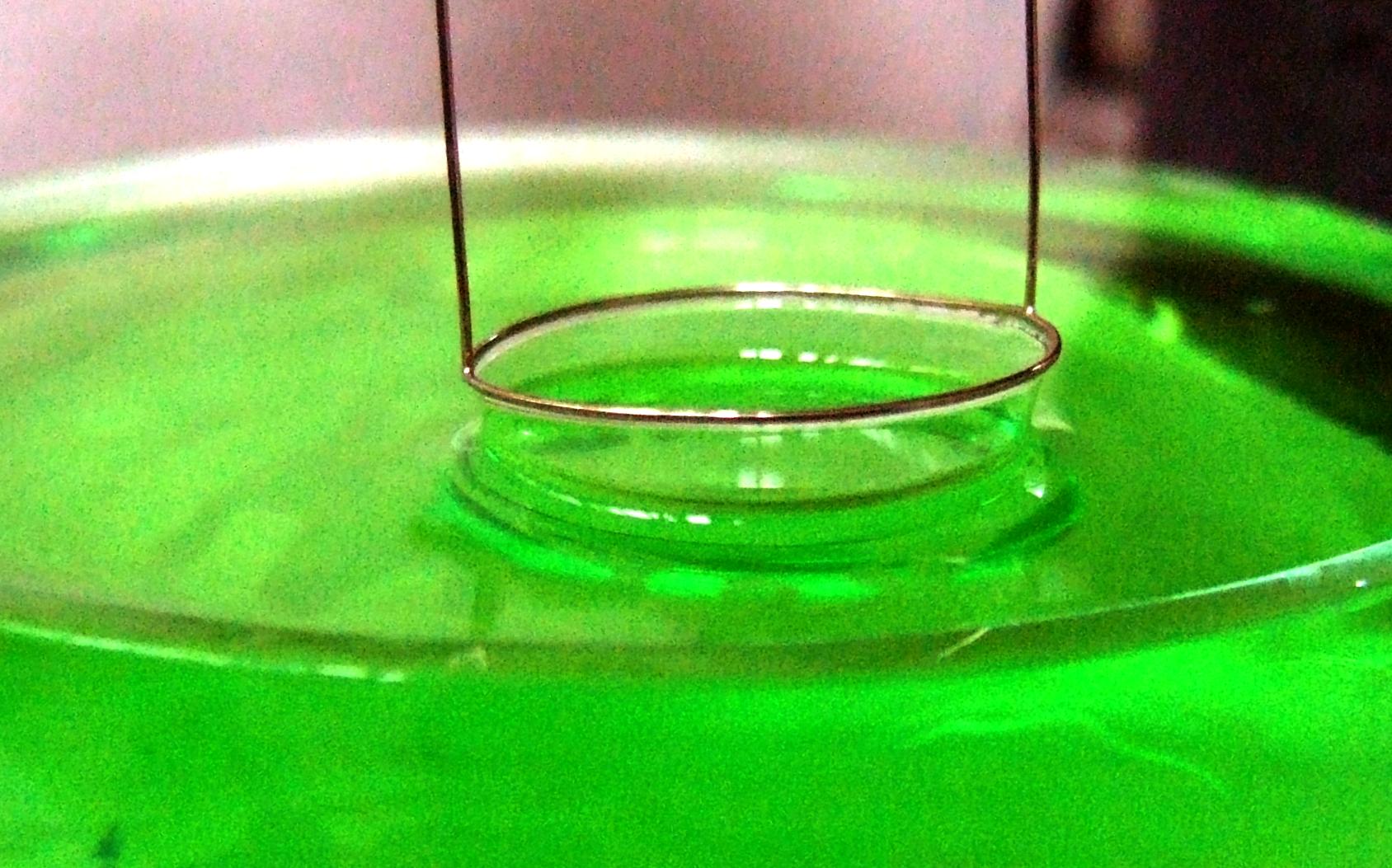Du Noüy ring method on:
[Wikipedia]
[Google]
[Amazon]
 In
In
 The most common correction factors include Zuidema–Waters correction factors (for liquids with low interfacial tension), Huh–Mason correction factors (which cover a wider range than Zuidema–Waters), and Harkins–Jordan correction factors (more precise than Huh–Mason, while still covering the most widely used liquids).
The surface tension and correction factors are expressed by
:
where is surface tension, is the average radius of the ring, and is correction factor.
The most common correction factors include Zuidema–Waters correction factors (for liquids with low interfacial tension), Huh–Mason correction factors (which cover a wider range than Zuidema–Waters), and Harkins–Jordan correction factors (more precise than Huh–Mason, while still covering the most widely used liquids).
The surface tension and correction factors are expressed by
:
where is surface tension, is the average radius of the ring, and is correction factor.
Video showing a classical torsion wire du Noüy tensiometer
Picture of a classical torsion wire du Noüy tensiometer
(National Institutes of Health) {{DEFAULTSORT:Du Nouy ring method Scientific techniques
 In
In surface science
Surface science is the study of physical and chemical phenomena that occur at the interface of two phases, including solid–liquid interfaces, solid– gas interfaces, solid– vacuum interfaces, and liquid– gas interfaces. It includes the ...
, the du Noüy ring method is a technique for measuring the surface tension
Surface tension is the tendency of liquid surfaces at rest to shrink into the minimum surface area possible. Surface tension (physics), tension is what allows objects with a higher density than water such as razor blades and insects (e.g. Ge ...
of a liquid
Liquid is a state of matter with a definite volume but no fixed shape. Liquids adapt to the shape of their container and are nearly incompressible, maintaining their volume even under pressure. The density of a liquid is usually close to th ...
. This technique was proposed by Pierre Lecomte du Noüy in 1925. The measurement is performed with a force tensiometer
Tensiometer may refer to one of a number of devices. The two most common are:
* Tensiometer (surface tension) an instrument used to measure the surface tension of liquids
* Tensiometer (soil science) an instrument to determine matric water p ...
, which typically uses an electrobalance to measure the excess force caused by the liquid being pulled up and automatically calculates and displays the surface tension corresponding to the force. Earlier, torsion wire balances were commonly used.
Description
The method involves slowly lifting a ring, often made of platinum, from the surface of a liquid. The force, , required to raise the ring from the liquid's surface is measured and related to the liquid's surface tension : : where is the radius of the inner ring of the liquid film pulled, and is the radius of the outer ring of the liquid film. is the weight of the ring minus the buoyant force due to the part of the ring below the liquid surface. When the ring's thickness is much smaller than its diameter, this equation can be simplified to : where is the average of the inner and outer radius of the ring, i.e. The maximum force is used for the calculations, and empirically determined correction factors are required to remove the effect caused by the finite diameter of the ring: : with being the correction factor.Correction factors
 The most common correction factors include Zuidema–Waters correction factors (for liquids with low interfacial tension), Huh–Mason correction factors (which cover a wider range than Zuidema–Waters), and Harkins–Jordan correction factors (more precise than Huh–Mason, while still covering the most widely used liquids).
The surface tension and correction factors are expressed by
:
where is surface tension, is the average radius of the ring, and is correction factor.
The most common correction factors include Zuidema–Waters correction factors (for liquids with low interfacial tension), Huh–Mason correction factors (which cover a wider range than Zuidema–Waters), and Harkins–Jordan correction factors (more precise than Huh–Mason, while still covering the most widely used liquids).
The surface tension and correction factors are expressed by
:
where is surface tension, is the average radius of the ring, and is correction factor.
Zuidema–Waters correction factors
H. H. Zuidema and George W. Waters introduced the following correction factor in 1961: : where : = maximum pull of rings dyn/cm">Dyne.html" ;"title="nowiki/>Dyne">dyn/cm : = density of the lower and upper phases, : : , : [s2⋅cm−1], : = Du Noüy wire radius, : = Du Noüy ring radius.Huh–Mason corretion factors
C. Huh and S. G. Mason described the correction factors as a function of and See the references.Harkins–Jordan correction factors
William Draper Harkins and Hubert F. Jordan tabulated the correction factors as a function of and .See also
* Sessile drop technique *Wilhelmy plate
A Wilhelmy plate is a thin plate that is used to measure equilibrium surface or interfacial tension at an air–liquid or liquid–liquid interface. In this method, the plate is oriented perpendicular to the interface, and the force exerted on ...
References
External links
Video showing a classical torsion wire du Noüy tensiometer
Picture of a classical torsion wire du Noüy tensiometer
(National Institutes of Health) {{DEFAULTSORT:Du Nouy ring method Scientific techniques